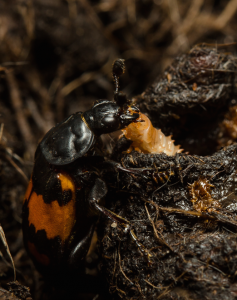Families lend themselves well to the experimental analysis of adaptations, because almost every trait expressed in family life has a measurable effect on fitness. We have shown that many of these adaptations results from social evolution: this means that their function is to influence the fitness of another family member (e.g. Kilner et al 1999, Kilner et al 2004, Hinde et al 2007, Russell et al 2007, Kilner & Hinde 2008, Hinde et al 2010).
Thus animal families are animal societies in miniature. And, just as with any other sort of animal society, we have found that individuals in families may cooperate (Schrader et al in press, Cotter & Kilner 2010) but may also be in evolutionary conflict (Hinde et al 2010, Boncoraglio & Kilner 2012).
Publications
Boncoraglio, G. and Kilner , R. M. 2012 Female burying beetles benefit from male desertion: sexual conflict and counter-adaptation over parental investment PLoS ONE 7:e31713
Cotter, S. C. and Kilner, R. M. 2010 Sexual division of antibacterial resource defence in breeding burying beetles, Nicrophorus vespilloides. J Anim Ecol 79:35-43
Hinde, C. A. and Kilner, R. M. 2007 Negotiations within the family over the supply of parental care. Proc R Soc B 274:53-61
Hinde, C. A. et al 2010 Parent-offspring conflict and coadaptation. Science 327:1373-1376
Kilner, R. M. et al 1999 Signals of need in parent-offspring communication and their exploitation by the cuckoo. Nature 397:667-672
Kilner, R. M. et al 2004 Brood parasitic cowbirds use host young to procure food Science 305:877-879
Kilner, R. M. and Hinde, C. A. 2008 Information warfare and parent-offspring conflict. Adv. Stud. Behav. 38:283-336
Russell, A. F. et al 2007 Reduced egg investment can conceal helper effects in cooperatively breeding birds. Science 317:941-944
Schrader, M. et al 2015 Parental care masks a density-dependent shoft from mutually beneficial to competitive sibling interactions in burying beetle broods. Evolution in press
Because parental behaviour functions to influence the fitness of others (see Social evolution within the family), we have found that parents can drive evolutionary change (e.g. Feeney et al 2013, Kilner & Langmore 2011, Langmore et al 2011). We applied the technique of experimental evolution to burying beetle families and showed that parents select adaptations in their offspring (Schrader et al 2015). Furthermore, our work suggests that the coadaptation of parent and offspring characters provides a mechanism for post-mating reproductive isolation, an early stage in the process of speciation. We showed experimentally that a mismatch in parent and offspring traits, which might arise in nature from hybrid pairings between diverging populations, results in reduced offspring fitness (Hinde et al 2010).
Publications
Feeney, W. E. et al 2013 Brood parasitism and the evolution of cooperative breeding in birds. Science 342:1506-1508
Hinde, C. A. et al 2010 Parent-offspring conflict and coadaptation. Science 327: 1373-1376
Kilner, R.M and Langmore, N. E. 2011 Cuckoos versus hosts in insects and birds: adaptations, counter-adaptations and outcomes. Biol Rev 86:836-852
Langmore, N. E. et al 2011 Visual mimicry of host nestlings by cuckoos. Proc R Soc B 278:2455-2463
Schrader, M. et al 2015 Using experimental evolution to study adaptations for life within the family. Am Nat in press
Parents can induce considerable variation in traits expressed by their offspring by varying the quantity and quality of nourishment they provide during development (e.g.Thorogood et al 2011), including traits that are not expressed until adulthood (e.g. Walker et al 2013). This is particularly evident from our (as yet unpublished) work on burying beetles. Our experiments therefore suggest that much of the individual variation upon which natural selection acts originates from variation in parental care received as an offspring.
Publications
Thorogood, R. et al 2011 Sense and sensitivity: responsiveness to offspring signals varies with parents’ potential to breed again. Proc R Soc B 278:2628-2645
Walker, L. K. et al 2013 A window on the past: male ornamental plumage reveals the quality of their early life environment. Proc R Soc B 280:20122852
We are interested in how parents manage interactions between the family and other species, and how these interspecific interactions drive selection on each member of the family.
We have a longstanding interest in the coevolutionary interactions between avian parents and brood parasites like cuckoos and cowbirds (Kilner & Langmore 2011).
But we are also interested in how parental diet during offspring provisioning can change key features of their developing young (Thorogood et al 2008, Thorogood et al 2011), which can persist into adulthood (Walker et al 2013a). For some species, this has important implications for their conservation (Walker et al 2013b).
Much of our current work focuses on how parents manage the microbial population that flourishes around the family (e.g. Cotter & Kilner 2010a, b) and whether associations between parents and phoretic mites and nematodes persist for this purpose (Cotter et al 2010).
Publications
Cotter, S. C. and Kilner, R. M. 2010a Personal immunity versus social immunity. Behav Ecol 21:663-668
Cotter, S. C. and Kilner, R. M. 2010b Sexual division of antibacterial resource defence in breeding burying beetles Nicrophorus vespilloides. J Anim Ecol 79:35-43
Cotter, S. C. et al 2010 Fitness costs associated with mounting a social immune response. Ecology Letters 13:1114-1123
Kilner, R. M. & Langmore, N.E. 2011 Cuckoos versus hosts in insects and birds: adaptations, counter-adaptations and outcomes. Biol Rev 86:836-852
Thorogood, R. et al 2008 Spectral mouth colour of nestling changes with carotenoid availability. Funct Ecol 22:1044-1051
Thorogood, R. et al 2011 Sense and sensitivity: responsiveness to offspring signals varies with the parents’ potential to breed again. Proc R Soc B 278:2455-2463
Walker, L. K. et al 2013a A window on the past: male ornamental plumage reveals the quality of their early life environment Proc R Soc B 280:20122852
Walker, L. K. et al 2013b Giving hihi a helping hand: identifying appropriate rearing diet in food supplemented populations of an endangered bird. Anim Conserv 16:538-545



